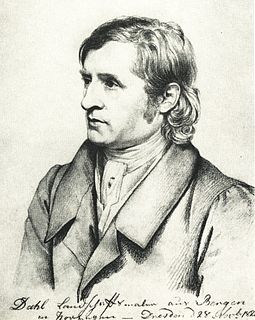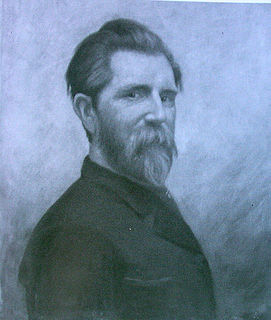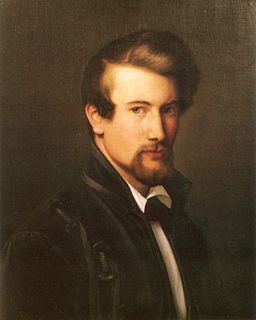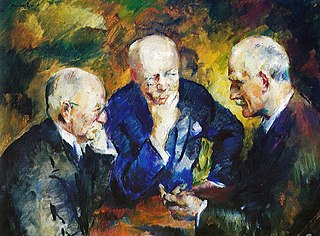
Christian Krohg was a Norwegian naturalist painter, illustrator, author and journalist. Krohg was inspired by the realism art movement and often chose motives from everyday life. He was the director and served as the first professor at the Norwegian Academy of Arts from 1909 to 1925.

Johan Christian Claussen Dahl, often known as J. C. Dahl or I. C. Dahl, was a Norwegian artist who is considered the first great romantic painter in Norway, the founder of the "golden age" of Norwegian painting, and, by some, one of the greatest European artists of all time. He is often described as "the father of Norwegian landscape painting" and is regarded as the first Norwegian painter to reach a level of artistic accomplishment comparable to that attained by the greatest European artists of his day. He was also the first to acquire genuine fame and cultural renown abroad. As one critic has put it, "J.C. Dahl occupies a central position in Norwegian artistic life of the first half of the 19th century.

Anton Alexander von Werner was a German painter known for his history paintings of notable political and military events in the Kingdom of Prussia. One of the most famous painters of his time, he is regarded a main protagonist of the Wilhelmine Period.

Hans Dahl was a Norwegian painter. Hans Dahl was famous for his paintings of Norwegian fjords and surrounding landscapes.
Rolf Dagfinn Groven is a Norwegian painter, known for his satirical art painted in figurative style. Groven's paintings are frequently printed works of art in textbooks used in Norwegian schools, as well as history books.

Adolph Tidemand was a noted Norwegian romantic nationalism painter. Among his best known paintings are Haugianerne and Brudeferd i Hardanger, painted in collaboration with Hans Gude.

Hans Fredrik Gude was a Norwegian romanticist painter and is considered along with Johan Christian Dahl to be one of Norway's foremost landscape painters. He has been called a mainstay of Norwegian National Romanticism. He is associated with the Düsseldorf school of painting.

Frits Thaulow was a Norwegian Impressionist painter, best known for his naturalistic depictions of landscape.

Otto Ludvig Sinding was a Norwegian painter, illustrator, poet and dramatist. Sinding drew on motives from Norwegian nature, folk life and history.

Erik Bodom was a Norwegian landscape painter.

Nødhavn Ved Norskekysten is a painting by Norwegian romanticist painter Hans Gude completed in 1873.

Kitty Lange Kielland was a Norwegian landscape painter.

For much of its history Norwegian art is usually considered as part of the wider Nordic art of Scandinavia. It has, especially since about 1100, been strongly influenced by wider trends in European art. After World War II, the influence of the United States strengthened substantially. Due to generous art subsidies, contemporary Norwegian art has a high production per capita.

Hjalmar Eilif Emanuel Peterssen was a Norwegian painter. He is most commonly associated with his landscapes and portraits.

Henrik Louis Lund was a Norwegian painter and graphic artist.

The Skagen Painters were a group of Scandinavian artists who gathered in the village of Skagen, the northernmost part of Denmark, from the late 1870s until the turn of the century. Skagen was a summer destination whose scenic nature, local milieu and social community attracted northern artists to paint en plein air, emulating the French Impressionists—though members of the Skagen colony were also influenced by Realist movements such as the Barbizon school. They broke away from the rather rigid traditions of the Royal Danish Academy of Fine Arts and the Royal Swedish Academy of Arts, espousing the latest trends that they had learned in Paris. Among the group were Anna and Michael Ancher, Peder Severin Krøyer, Holger Drachmann, Karl Madsen, Laurits Tuxen, Marie Krøyer, Carl Locher, Viggo Johansen and Thorvald Niss from Denmark, Oscar Björck and Johan Krouthén from Sweden, and Christian Krohg and Eilif Peterssen from Norway. The group gathered together regularly at the Brøndums Inn.

Morten Müller was a Norwegian landscape painter.

Gustaf Werner Holmberg was a Finnish landscape painter.

Bridal Procession on the Hardanger is an 1848 painting by Hans Gude and Adolph Tidemand. It is one of the best known Norwegian paintings. Gude painted the landscapes and Tidemand the bridal party. The painting is 93 x 130 cm, and is in the National Gallery in Oslo. It is considered to be an excellent example of romantic nationalism in Norway.


















